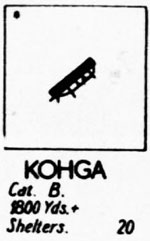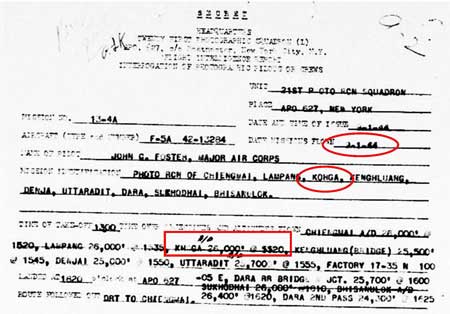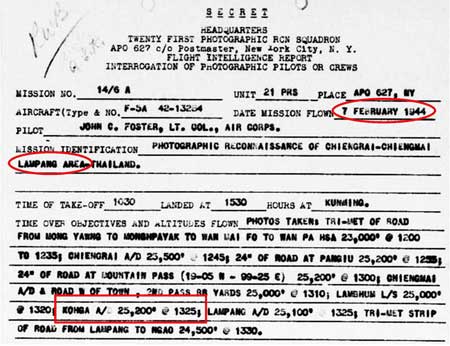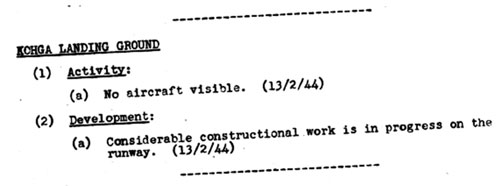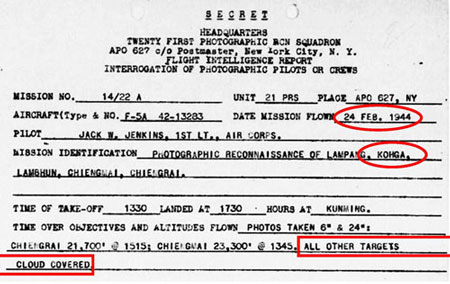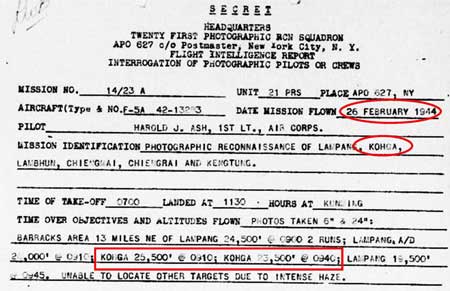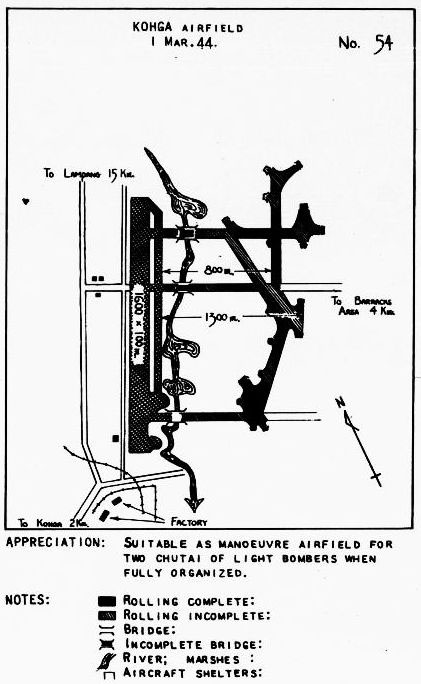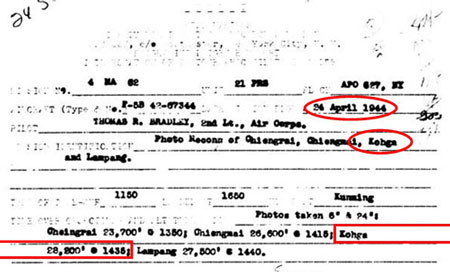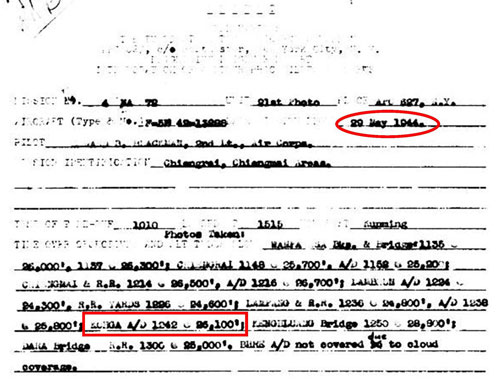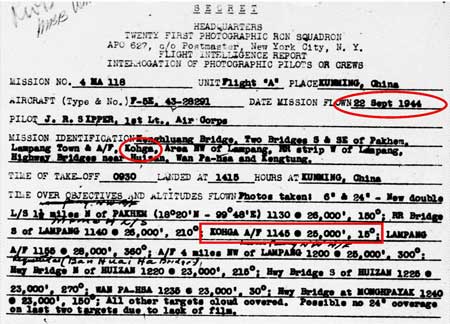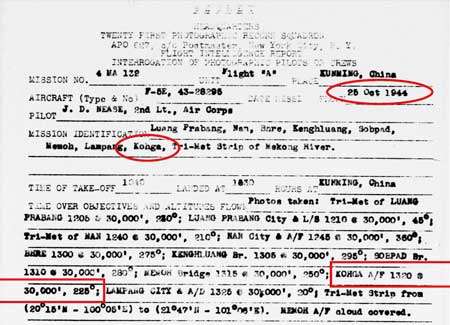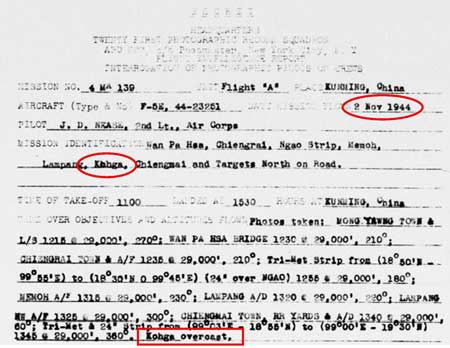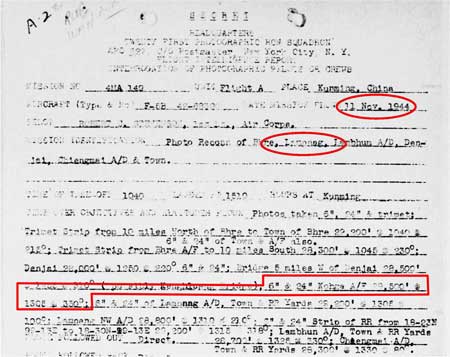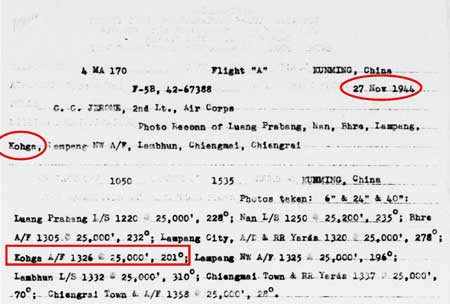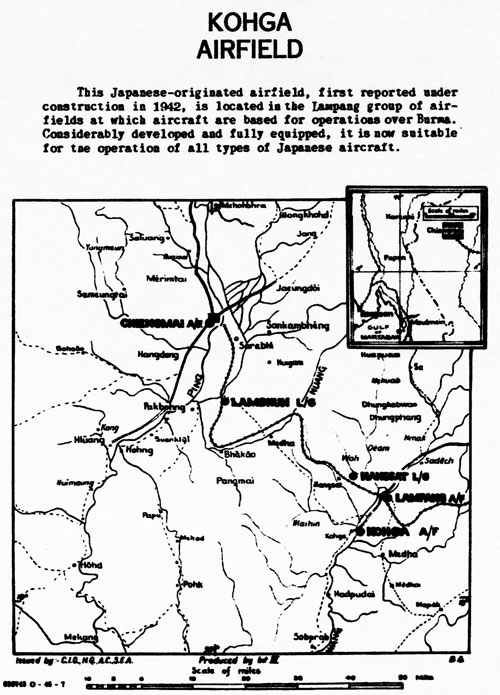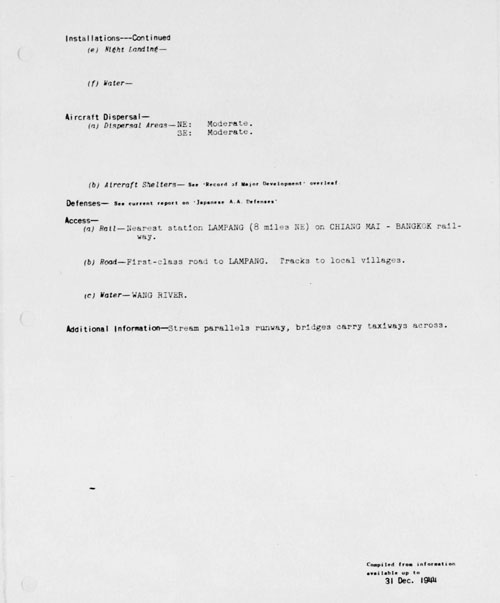| N18°11.90 E99°24.67 |
Ko Kha Landing Ground (Th: เกาะคาท่าอากาศยาน/ Jp: コカ滑走路) Lampang Province Page 2 of 3 |
Route 0001 Sta 690~ |
| Text | Notes | ||||||||||||||
|
January 1944: This was the first month that Allied intelligence claimed that the Ko Kha airstrip was constructed by the IJA (the black dot, actually an asterisk, at the top left of the miniature so indicated):[3]
This assertion as to origin conflicts with RTAF official history. See entry for 22 December 1941.
Regardless, key information is that the runway had apparently been "metaled",[3å1] making it all-weather, in contrast to Lampang Airfield which was not "metaled", ie, all-weather. Potential reasons for this seeming oddity: 1. Both towns were located on the main north-south highway for
This was the last photo report from 21 PRS for seven months: the next being on 22 September.
• The eventual capacity of the facility was estimated at two The diagram is also frustrating because, while it is supposedly coded per the "Notes" following, the coding is unclear in this reproduction; while symbols for aircraft shelters are listed, none appear in the actual diagram.
Transcription of relevant parts, with emphasis mine: By November 1943 evidence began to accumulate that the enemy were paying greater attention to their Thailand bases. Their Burma positions had been consolidated and with the threat of the increased pressure which it must have been anticipated the Allies could apply, it was apparent that some secondary form of defence line was necessary, not only because of the possibility of relinquishing territory in Burma, but also to accommodate such increased air strength as they might consider necessary for employment in operations either planned or threatened. . . . . . . Between these two important bases [of Chiang Mai and Bangkok] and along the railway which provides facilities from the one to the other, has been the area of steady and progressive development and this does in fact constitute the main Thailand line of airfields. At the northern end, in close proximity to [Chiang Mai], Lampang and Ko Kha have been extended and additional facilities have been provided. . . . This then constitutes the position as it appears today, though it is considered that this is not necessarily a complete picture and that it is but the commencement of the Japanese objective. The [Chiang Mai] group of airfields is bound to be strengthened in view of its strategic position for providing air cover over Rangoon and the whole of the Irrawaddy Valley . . . . Note that this review was prepared before the IJA's not defensive effort, but rather its offensive began to invade India, for which troop and equipment movement was already well underway when this review was prepared. The invasion turned into a rout, and Japan did indeed find itself "relinquishing territory in Burma". While evaluating Thai airfield improvements as possibly to "accommodate . . . increased air strength", Allied intelligence, while noting the many aircraft at Bangkok at this time, failed to consider the consistent lack of aircraft reported on airfields in the northwest of Thailand: for example, despite 32 aircraft shelters at Ko Kha, no aircraft had ever sighted there. An important concept first appeared here, "the main Thailand line of airfields". It would first be graphically presented in October 1944's Airfield Report.[5b1]
The airfield is described as located "one mile southeast of Ko Kha"; elsewhere it is northeast. The airfield is described as located "west of Pun River"; the waterway does not appear on any map; however, the Huai Het Lom, a stream, flows south through Ban Mae Pun, about 500 m directly east of the south end of Ko Kha airstrip.[5d2]
Local position below corrects the relationship of the airstrip to Ko Kha village --- "NE", northeast, not "northwest" as previously stated. The "small tributary" mentioned in the "Local Position and Landmarks" would have been the Pun named in the May 1944 report.
TRANSCRIPT: Coordinates --- 18°12'N; 99°25'E
|
3.^ Airfield Report No. 18 (Jan 1944), unnumbered page (USAF Archive microfilm reel A8055 p0432).
3å.^ 21st Photographic Reconnaissance Squadron (hereafter 21PRS) Report Mission No. 13-4A, 09 Jan 1944 (USAF Archive microfilm reel A0878 p0197). AD might also mean an all‑weather runway, or a complete facility.
3å1.^ "Metaled" in WW2 time probably meant gravel covered. From 1951, Brown, et al, Geologic Reconnaissance of the Mineral Deposits of Thailand (Washington: USGPO, 1951), under the heading "Road Metal" (p 139): ". . . 80 percent of the road metal used in Thailand is limestone. . . . Drilling and breaking is usually done by hand . . . there are many small quarries along the highways of Thailand." Wikipedia's Road surface explains further: Only after the war, the term evolved: "Road metal" later became the name of stone chippings mixed with tar to form the road surfacing material, tarmac.' And a bit of trivia, regarding the term, tarmac, Wikipedia's Airport apron-Tarmac notes: ". . . the general public . . . refer to the apron at airports as "the tarmac" despite the fact that most of these areas are often paved with concrete not tarmac." 3a.^ Airport Report No. 18 (Jan 1944), "Part II - Amendments to Airfield Lists", page 35
4.^ 21PRS Report Mission No. 14/6 A, 07 Feb 1944
4a.^ Airport Report No. 19 (Feb 1944), "Record of Airfield Activity and Development", page 23 (USAF Archive microfilm reel A8055 p 0523).
4b.^ 21PRS Report Mission No. 14/22 A, 24 Feb 1944
5.^ 21PRS Report Mission No. 14/23 A, 26 Feb 1944
5å.^ "Unit Structure of IJA Air Force" in Mark's Index: Japanese Aviation.
5a.^ Plans of Airfields in French Indochina and Siam (? South-East Asia Translation and Interrogation Center, 30 Nov 1944), "Order of Battle", unnumbered page (USAF Archive microfilm reel A8023 p 0438). The crudity of the sketch suggests that the source had been on-the-ground which would be in keeping with the document publisher, ". . . Interrogation Center", rather than aerial photography.
5b.^ Airport Report No. 21 (Apr 1944), "Review of Airfield Development in Thailand", pp 4, 5
5b1.^ Airport Report No. 27 (Oct 1944), "Comments on Current Airfield Development", following p ii (USAF Archive microfilm reel A8055 pp 0999- 1002). See below. What was meant by the 5b2.^ 21PRS Report Mission No. 4 MA 62, 24 Apr 1944
5c.^ Airport Report No. 21 (Apr 1944), "Record of Airfield Activity and Development", page XVII (USAF Archive microfilm reel A8055 p 0713).
5d.^ Airport Report No. 21 (Apr 1944), unnumbered page (USAF Archive microfilm reel A8055 p 0666).
5d1.^ Provisional Airfield List: Southeast Asia (Washington: Office of Assistant Chief of Air Staff, Intelligence, 25 Jul 1944), page 61 (USAF Archive microfilm reel A1284 p 1411). Applicable glossary is on page 1 of the publication (USAF Archive microfilm reel A1284 p 1350). The "miniature" displayed under DIMENSIONS, with its peculiar "tails" cannot be matched with any that were presented in regular issues of Airfield Report.
5d2.^ Royal Thai Survey Department 4845 II, L7017, dated 1992.
5e.^ Airport Report No. 22 (May 1944), "Record of Airfield Activity and Development", page 14 (USAF Archive microfilm reel A8055 p 0752).
5e1.^ 21PRS Report Mission No. 4 MA 72, 29 May 1944
5f. (deleted).
5g.^ Airport Report No. 26 (Sep 1944), "Record of Airfield Activity and Development", page 10 (USAF Archive microfilm reel A8055 p 0988).
6.^ 21PRS Report Mission No. 4 MA 118, 22 Sep 1944
Or more correctly, this was the first aerial photo order to 21PRS since February. There is ample evidence in the form of occasional photos with credits that other PRSs (Photographic Reconnaissance Squadrons) were operating in the area; but no records have been released. And conversely, no photos have been found to date credited to 21PRS.
6a.^ Airport Report No. 27 (Oct 1944), "Record of Airfield Activity and Development", page 9
7.^ 21PRS Report Mission No. 4 MA 132, 25 Oct 1944
8.^ 21PRS Report Mission No. 4 MA 139, 02 Nov1944
9.^ 21PRS Report Mission No. 4 MA 140, 11 Nov 1944
9a.^ Airport Report No. 28 (Nov 1944), unnumbered page (USAF Archive microfilm reel A8055 p 1085).
10.^ 21PRS Report Mission No. 4 MA 170, 27 Nov 1944
10a.^ Siam (Thailand) List of Airfields and Seaplane Stations (Washington: Office of Assistant Chief of Air Staff, Intelligence, 1945), unnumbered page Previous reports have inconsistently referred to Ko Kha as an LG / Landing Ground, AD / Airdrome, and AF / Airfield --- each of which has a different meaning.
10b.^ Airport Report No. 29 (Dec 1944), "Record of Airfield Activity and Development", page 7
10c.^ Siam (Thailand) List of Airfields and Seaplane Stations (Washington: Office of Assistant Chief of Air Staff, Intelligence, 1945), unnumbered page Data reflected information available up to 31 Dec 1944.
10d.^ ibid. (USAF Archive microfilm reel A1285 p 1191).
|
